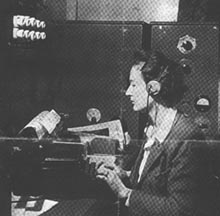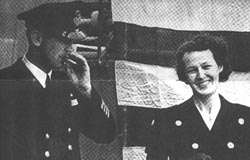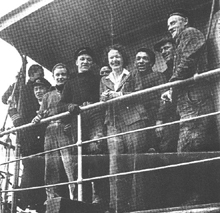
|
 |
 |

|

DID WOMEN SERVE AT SEA IN WWII?
Pioneer Canadian Wireless YLs
The
first woman in Canada to earn a professional operator's license, she was
also the first woman to serve as Sparks in the Norwegian Merchant Navy.
Fern passed away in 1991 at the age of 73.

| This eye-catching question appeared a few years ago on
the glossy cover of an American magazine called Sea Classics.
Inside this same magazine,
| Maritime historian, Ian A. Millar, posed
another question in very large caps.
"WHO SAYS WOMEN DIDN'T
SERVE AT SEA IN WWII?"
Millar went
on to declare that "Few today realize that Norway's exiled wartime
merchant marine allowed women radio operators to serve aboard with
Norwegian-flagged merchant men."
A pity this magazine didn't get widely distributed in Canada because in
his article, Millar also stated...'In spite of YLs holding identical
commercial licenses to their male counterparts they faced a closed door
both during and after the war. They were a very small number, this group
of pioneer wireless operators.' and he followed this declaration by
listing the names of these women, all Canadian, their ships, and theatres
of war in which they sailed.
That handful of Canadian women served at sea during the war years, and
immediately following, is virtually unknown here in Canada and would
perhaps be met by disbelieving stares, shrugs or indifference.
Such was the attitude also shared by the Canadian government back in
the war years. When the Norwegian tanker Kaptein Worsoe arrived in an
Australian port late in 1944, newspapers 'Down Under' made much of the
fact that the 2nd and 3rd wireless operators aboard were two young women
from British Columbia. No mention was made of the name of the ship, or
port of arrival, only that the girls were serving aboard an allied (not
Canadian) vessel.
Inevitably this story was picked up by news services in Canada and a
reporter asked a Canadian official if this now meant that women would be
allowed to serve aboard Canadian vessels. The response was a horrified,
'Good God no, we have enough trouble on ships now without having women on
board!'
With the Battle of the Atlantic continuing for most of the duration of
WWII, ship losses meant losses of trained personnel, among them the
wireless operator. Fortunately the Norwegians displayed no hesitation in
accepting those few Canadian women who volunteered. As far as can be
determined at this late date, records being impossible to track down, at
least ten Canadian women sailed wartime and seven in the post war years.
Who were these unknown and unsung
wireless pioneers?
One such pioneer was:

FERN BLODGETT
1918 - 1991
The first, and the only one about whom much detail can
be obtained, was Fern Blodgett, a young Ontario Women who grew up in
Cobourg Ontario during the '20s and '30s. Watching Great Lakes' steamers
passing along the shores of Lake Ontario, Fern had childhood dreams of one
day becoming a sailor and travelling the world, a life definitely not open
to women at that time.
When war broke out in 1939 Fern was employed in the steno pool of a
large manufacturing firm in Toronto. Bent on doing something to fight
against the Germans, Fern's youthful wish to go to sea was reawakened when
the Merchant Marine began recruiting wireless operators in Canada. She
applied to three wireless schools before being taken seriously and
accepted as a student. Working as a steno by day, Fern attended night
school for almost 18 months before writing her exams, which she passed
among the top of the class. Her 2nd class wireless operator's license and
a call to go to sea arrived on the very same day. There was no chance of
her forgetting that date - it was a Friday the 13th, June of 1941. Fern
had often told her radio school principal that she would like to become a
ship's Sparks and when he learned of an opening in Montreal, he
immediately phoned to her place of employment and asked if she was still
interested? Her answer - a very definite 'Yes'.
That same night Fern was on the train to Montreal, and when she arrived
there next morning, authorities were dismayed to discover that F. Blodgett
was a woman. There was nothing in regulations to say that a woman could
not sail as a wireless operator, but it was pretty obvious the 'powers
that be' weren't exactly enamoured of the idea. Fortunately for her the
decision was left up to the ship's master. Captain Gerner Sunde of the
fruit carrier Mosdale had been waiting days for an operator and didn't
want to wait any longer. He spoke with Fern, and since she seemed self
assured and sounded competent, he hesitated only a few moments before
agreeing to sign her on.
Once clear of the St. Lawrence River on that first trip, Fern became
violently seasick. However, being the sole operator, she had no choice but
to stick it. Handed a bucket to keep at her feet, she somehow coped. Fern
gained her sea legs in time and soon proved to be a capable operator, but
she often battled seasickness and only fellow sufferers can truly
empathize.

Fresh from radio school, with absolutely no experience in operating,
decoding, or any of the necessary copious amounts of paper work, Fern
found herself in charge of Mosdale's radio shack. At first, as the only
operator, she later became the Chief Operator with an English 2nd and a
Norwegian 3rd.
Of the half dozen fruit carriers from Norway to start the crossings in
1940, only Mosdale survived. A fast ship capable of 15 knots she often
traveled alone. The crew hated it when they were assigned to so-called
fast convoys of 8 knots.
In all, Mosdale made 98 crossings of the Atlantic of which Fern was
aboard for 78. Many times she witnessed the horrors of torpedoing and the
loss of ships and men. Asked why she went to sea when it was so dangerous,
she is reported to have answered.
"Why
should I not risk my life when millions of men are risking theirs. Is a
woman's life more precious than a man's?"
In the normal way of things Gerner Sunde was rather young
at 30 to be Master of a vessel and not at all the old greybeard Fern had
been expecting as a skipper. Romance flourished and captain and operator
became engaged December of '41 and married the following year. Their
honeymoon was spent at sea in convoy.
In July of 1943 when Mosdale was in the U.K., Capt. Sunde and others
attended a special luncheon ashore where they met the Norwegian Royal
couple Prince Olav and Princess Martha and were presented with medals by
King Haakon VII.
Mosdale was a happy ship but the war's end came in time.
Nerves had been stretched to the breaking point as everyone wondered how
long their luck could last. In December of '45, after almost four and a
half years on the harsh North Atlantic run, Fern left the ship to settle
down at Kjorestad in her new homeland of Norway. Her story does not have
an '.... and they lived happily ever after' ending for Captain Sunde died
suddenly of a heart attack
Fern was left to raise two small daughters in strange surroundings and
carried on with exceptional determination and fortitude. So highly
respected by the small city of Farsund where she made her home, Fern was
awarded a medal in 1988 in recognition of the special distinction she had
brought to the city. As well, Fern had also earlier received a medal from
the Norwegian government for her wartime services.
Written by: Olive
Roeckner, VE7ERA, Mirror Lake, Kaslo, B.C.
Olive visited Fern in Norway in June 1991. Fern passed away a couple of
months later. The book about the Lucky Mosdale is called just that
and was written by Filiv Odde Hauge.
Copyright
�

Back to Top

 YLRadio Home
YL
Archives YLRadio Home
YL
Archives 

1999-2011
|
|